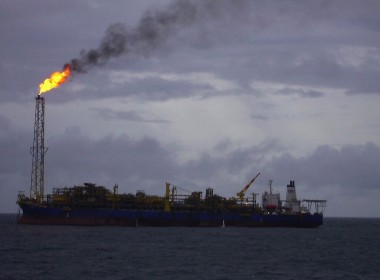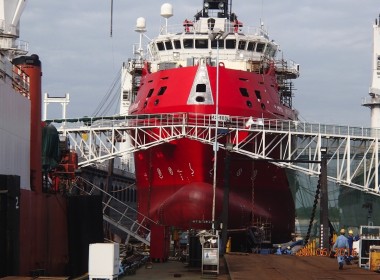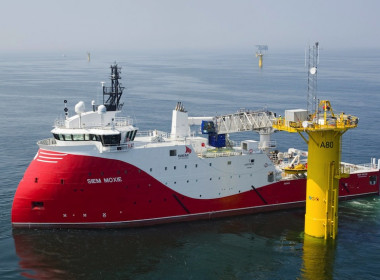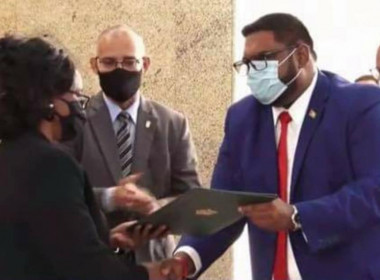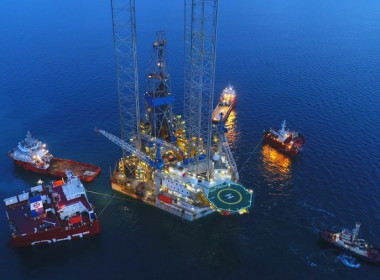COLUMN | Quick updates: historic corruption in Nigeria and fraud in India: The Metals Company pilot tests Hidden Gem; Ocean Infinity’s Armada at sea and Red Rock sold; Cadeler raises more cash [Offshore Accounts]

Time for a quick and dirty look at three of our favourite topics – corruption in oil and gas, new marine technology, and the wind industry.
Just to be clear, there is no imputation or allegation of any corruption intended or implied outside the stories about Nigeria and India. Except in the British Virgin Islands (BVI).
As usual.
Nigerian failure
Last week’s column on the multiple woes impacting Nigeria provoked some criticism from readers in Africa’s most populous country. They didn’t dispute any of the factual points I made (here). Instead, they said that Covid had led to oil wells being shut in, and that it took time and effort to restart them, which, they claimed, explained Nigeria’s falling production.
This ignores the fact that between 2019 and today, Nigeria slumped from being the largest oil producer in all of Africa to being the fourth largest today, with production that is lower than it was in 1990!
All countries experienced the calamitous fall in the oil price to less than US$30 a barrel in April 2020, some wells were shut in, and some development plans were delayed pretty much everywhere. But Nigeria has been slammed hard because of its failure to attract investment in new exploration and production, and because of its failure to manage its existing oil and gas assets properly.
Indeed, in July, Addax’s Nigerian workforce went on strike, reducing production by 22,000 barrels of crude per day (bpd), according the local press (here).
Addax’s dark roots in the days of dictatorship
At the heart of Nigeria’s problems lie bad governance, bribery and corruption, and a system designed to enrich insiders. A recent report by the Organised Crime and Corruption Reporting Project (OCCRP) highlights the crooked beginnings of Addax’s operations in Nigeria in the 1990s (here).
Addax is one of Nigeria’s largest and most prominent oil producers, and is very active in the trading of refined products right across Africa. The company is owned by China’s the Sinopec Group, and operates four Oil Mining Licences in Nigeria, OML 123, 124, 126 and 137, working under Production Sharing Contracts with the Nigerian National Petroleum Corporation (NNPC).
Addax’s success was remarkable, as the company started with nothing. Despite having no record in oil and gas exploration and production, Addax was awarded the licences formerly held by Ashland by the Nigerian government in 1998.
In the words of OCCRP, “the deal set off a spectacular rise for the Swiss-based firm,” which had been founded in 1987 in Geneva by four Swiss businessmen and was registered in the BVI.
From 1998 until 2009, Addax increased production in these licence areas to about 130,000 bpd, according to PoliticsNigeria (here). However, in recent years, there have been no new investments in the assets, a massive tax dispute with the government in Abuja has ensued, and by 2021, Addax’s production in Nigeria had declined to around 25,000 bpd.
Nigerian president and oil minister and his brother benefit
Addax had started out trading refined oil products and then moved into storing and distributing oil products in sub-Saharan Africa. In 1994, the parent company founded Addax Petroleum and began to aggressively court the military ruler of Nigeria, General Sani Abacha.
OCCRP found that “Addax’s first activities in Nigeria were dedicated to helping Abacha and his associates set up financial infrastructure to receive millions of dollars’ worth of bribes, according to later court findings… Working on a tip from France’s Finance Ministry, French investigators would later find that Richard Granier-Deferre, a French-born Addax Petroleum executive in Geneva, had opened accounts on behalf of Abacha’s two oldest sons at Banque Edouard Constant in Geneva in 1995. He also set up an account for Bukazi Etete, the brother of Nigeria’s oil minister at the time, Dan Etete.”
Did Glencore do that, too?
Addax executives later testified to a French court that they had paid US$5 million in bribes into the Swiss bank account of Nigeria’s oil minister during Abacha’s presidency to win the four oil blocks. Further sums were paid by Addax into the account of Etete’s brother. UK-listed miner and commodity trading house Glencore also paid millions of dollars into the same account belonging to Bukazi Etete, OCCRP has found.
We have covered Glencore’s recent US$1.5 billion fines for bribery in Africa here.
“Your joint account is with your wife? Oh, with the former head spy of Nigeria…”
Addax staff then opened a number of curious joint bank accounts in Switzerland with leading African figures as co-signatories to the accounts. The co-signatories included Maurice Nguesso, who just happened to be the brother of the president of Republic of Congo, and Umaru Ali Shinkafi, the former Nigerian spy chief who also happens to be the father-in-law of the current governor of Kebbi state, Atiku Bagudu.
It speaks volumes of Nigeria’s political system that in 2014, the US Department of Justice compelled Atiku Bagudu to hand over millions of dollars of funds, which were the proceeds of corruption looted from the Nigerian government under President Abacha. Yet this man is still governor of a Nigerian state today. Read the indictment and weep (here).
China fails to address overseas bribery
By 2005, Addax was Nigeria’s largest independent oil producer, producing over 65,000 bpd. In 2006, Addax Petroleum was listed in Toronto for US$2 billion, and then in 2009 it was sold to Sinopec for over US$7 billion, as production continued to surge.
During the preceding ten years, over one hundred million dollars of dividends and Addax Petroleum shares were either paid into the joint accounts, or given to the lucky beneficiaries of the accounts.
Some of the accounts remained open after the sale of the business to Sinopec. In 2017 the Chief Executive Officer at Addax’s Geneva Office, Zhang Yi, and the company’s legal director were arrested over yet more alleged bribery schemes carried out by the firm in Nigeria, according to Nigeria’s Premium Times here.
Addax eventually reached an agreement with Swiss prosecutors in 2017 to pay what is today US$31 million to settle the bribery charges against some officials in Nigeria. Further sordid details of the post-Sinopec bribery allegations are here.
No officials in Nigeria seem to have been convicted, however. Strange, that.
Anti-corruption watchdog Transparency International recently noted that China conducted “little to no enforcement” of laws against foreign bribery by Chinese companies.
ABG Shipyard – India’s biggest fraud, ever
Transparency International also noted that India still has no legislation criminalising foreign bribery.
Yes, you read that correctly: it is not a criminal offence in India to pay bribes overseas.
However, the most sensational of recent Indian corruption scandals is not focused on foreign bribery, but on fraud and embezzlement by an Indian shipbuilder, ABG Shipyard.
ABG had won a reputation for building offshore vessels at lower prices than rival yards in Northern Europe and Singapore in the early 2000s, and was famous for winning a contract for nine AHTS from John Fredriksen’s Deep Sea Supply (Sea Wolverine, Sea Jackal and sisters), along with anchor handlers for Italy’s Marnavi, a diving support vessel for Vroon of the Netherlands, two vessels to the Lamnalco Group in the UAE, and two AHTS for Egyptian owner Maridive.
The quality wasn’t great (a common problem across the entire Deep Sea Supply fleet), but the prices were cheap, I am informed. ABG also won contracts outside the offshore sector, including 12 vessels of approximately 32,000 DWT from Precious Shipping Public Company of Thailand, four bulk carriers of 54,000 DWT, and construction of 11 interceptor boats for the Indian Coast Guard.
After 2012, ABG’s finances deteriorated, and in 2013 it was in default on its loans, mainly to domestic Indian banks including several state banks.
Forensic audit reveals massive scam, founder arrested as a cheat
The creditors commissioned a Forensic Audit report by Ernst and Young to investigate where their loans had gone. Ernst and Young found that from the period of April 2012 to July 2017, the management of the yard and board members “colluded together and committed illegal activities including diversion of funds, misappropriation and criminal breach of trust and for purposes other than for the purpose for which the funds are released by the Bank”, as reported by MSN here.
India’s Central Bureau of Investigation (CBI) last month arrested ABG’s founder and chairman Rishi Kamlesh Agarwal in connection with what it claimed was the alleged bank fraud of more than Rs 22,842 crore or INR228.42 billion (US$2.7 billion).
Where did that US$2.7 billion go, exactly?
Reading Indian financial statements is tough for non-Indians, and so you are probably wondering exactly how much one crore is worth. One crore is ten million rupees, or around US$121,951 at the current exchange rate of 82 rupees to the US dollar; so, 22,842 crore is US$2.7 billion.
The central probe agency had registered a case against him and few others in February of this year and had carried out searches at 13 locations just days after filing the case. The Indian enforcement agency had charged Agarwal and others for criminal conspiracy, cheating, and criminal breach of trust, under the Indian Penal Code and the Prevention of Corruption Act.
State Bank of India robbed
The case was based on a complaint filed by the State Bank of India (SBI), according to BusinessToday (here). In a statement issued in February, the CBI said that ABG Shipyard had been in business with the SBI since 2001. The shipbuilding company had secured credit facilities of Rs 22,842 crore and the majority of the disbursement happened between 2005 and 2012 from a consortium of 28 banks led by SBI and ICICI Bank.
The CBI claims that the 28 banks gave the shipyard billions of dollars of loans, and then the directors and management stole them, diverting the bank loans from one of ABG’s overseas subsidiaries to their own accounts.
The wheels of justice turn remarkably slowly in India, but the charges against ABG’s founder and his arrest at least bring some clarity to what may have happened in the collapse of what had been India’s largest and most successful shipbuilding group.
Obviously, Mr Agarwal and his co-accused are innocent until proven guilty and have not been convicted of any crimes relating to the allegations at the time of writing, so nothing in our coverage should be construed to claim any wrong-doing on their part. Just to be clear.
The Metals Company’s vacuum cleaner nodule collector works at 4,000 metres of water
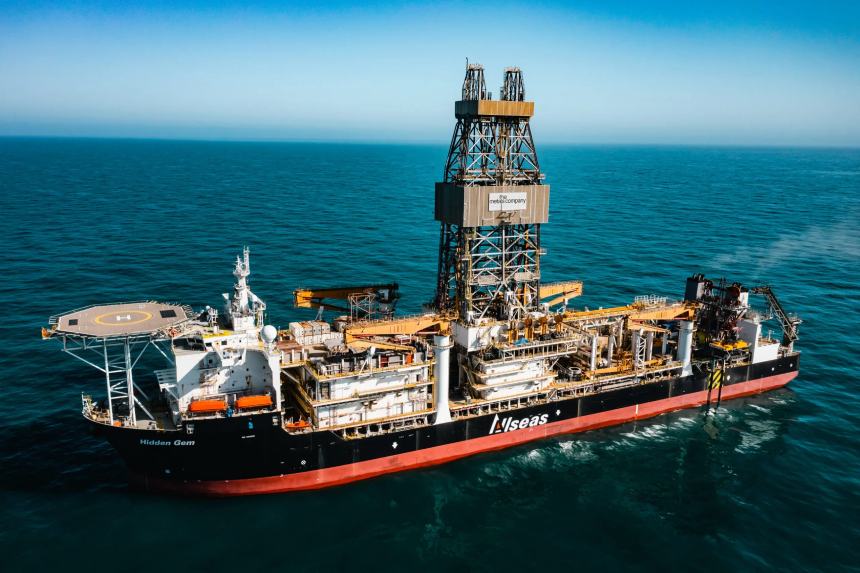
Moving swiftly on from allegations of cheating, we move to look at two technological milestones achieved this month. Firstly, The Metals Company announced that it had succeeded in collecting polymetallic nodules from the deep seabed in the Pacific (here). During a 60-minute pilot collection run across around 150 metres of the seafloor, approximately 14 tonnes of nodules were collected by the pilot collector vehicle, transported to the surface using a 4.3-kilometre-long riser system and placed into the hold of the surface production vessel Hidden Gem, a converted drillship owned by Allseas.
The Metals Company stock promptly shot up 20 per cent upon the release of the announcement, and then fell nine per cent the next day, to close at US$1.07 on Friday. The company said that this was the first such test in the Clarion Clipperton Zone of the Pacific Ocean since the 1970s, when 1,500 tonnes of nodules were gathered. The Metals Company claims that the pilot trials show that the Allseas-designed nodule collection system can withstand the pressures and temperatures of its deep-sea operating environment.
What happened on the seabed?
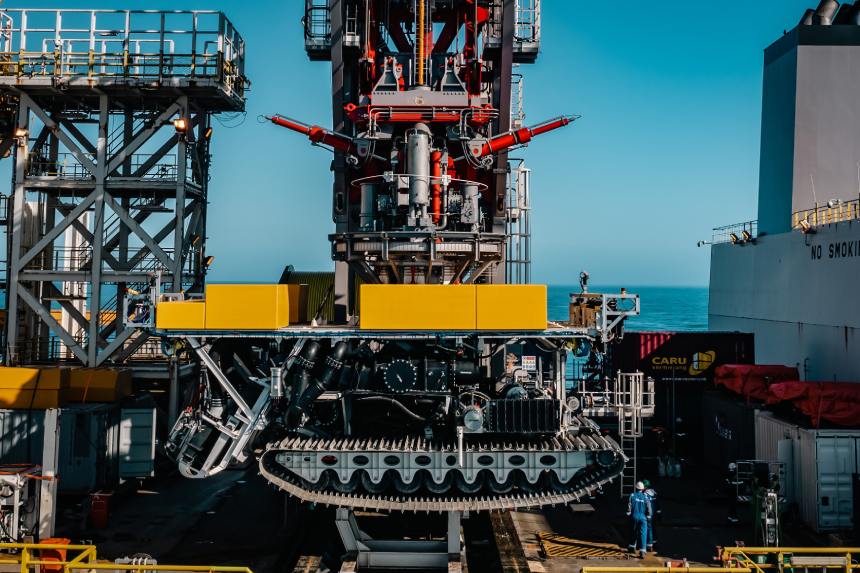
“Conducted in a small test area… the ongoing collection system trials and concurrent environmental impact monitoring campaign are part of the International Seabed Authority (ISA)’s regulatory and permitting process and will provide critical environmental data to inform The Metals Company’s subsidiary NORI’s application to the ISA for an exploitation contract,” the company said.
Let’s see what evidence of the environmental impact of the pilot mining the research programme reveals. Greenpeace and other environmental campaigners remain staunch in their condemnation of the impact of subsea mining on the little-studied and fragile eco-systems of the deep Pacific (here).
Subsea mining may have overcome some of the technical issues associated with the nodule gathering, but the fate of the industry will rely on overcoming these environmental and political objections.
Ocean Infinity: Subsea Mining participation, Armada Sea Trials and Red Rock sale
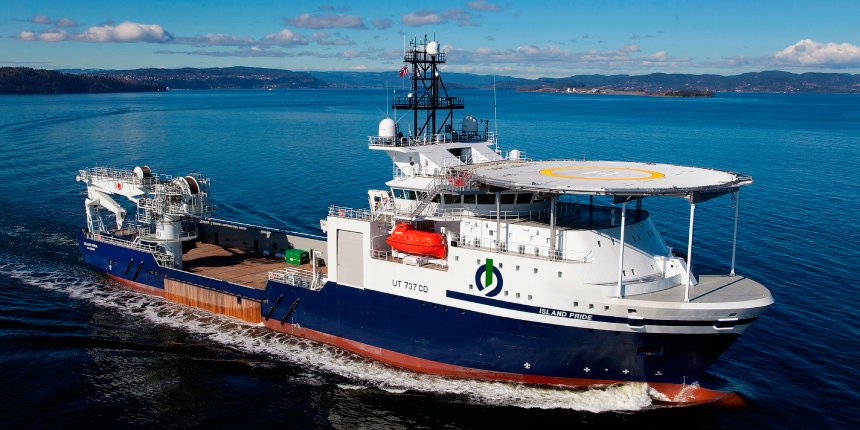
One of the interesting nuggets from the Metals Company press release was that the company was using “a dedicated 103-metre-long monitoring vessel” to conduct research on the subsea mining trial. Onboard this vessel, “expert industry contractors and independent scientists from leading research institutions from around the world are conducting a complex monitoring program to assess the environmental impacts of the collector system trials using an array of over 50 subsea sensors and monitoring stations.”
Strangely, AIS data (here) showed that Ocean Infinity’s 103-metre-long subsea vessel Island Pride sailed from San Diego for an unknown offshore location in the Pacific at the end of September. This seems more than a coincidence…
Let’s hope activists don’t arrive at Silicon Wharf in Southampton to protest the company’s involvement in such a controversial project as deepsea mining.
Testing offshore with crew
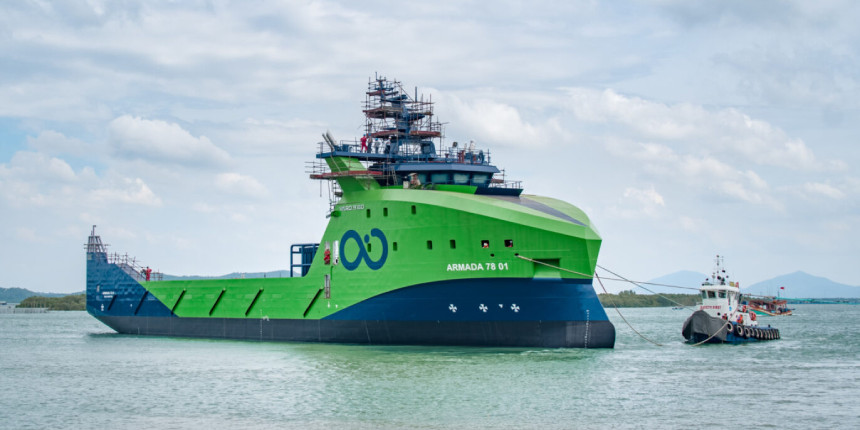
Ocean Infinity has also announced a major milestone of its own. Its first 78-metre Armada vessel is undergoing sea trials off Vietnam and will shortly deliver from Vard shipyard in Vietnam (great video here).
Of course, the trial is with full crew onboard, as the integration and testing of the company’s remote-control systems for uncrewed operations will only occur after the delivery of the ship from Vard, we understand. We look forward to seeing progress here after years of waiting.
Red Rock bleeds?
Ocean Infinity has recently gained more focus. Firstly, it reversed its take-over of marine security provider Ambrey Risk in less than eight months, and sold the business back to its original owners, as we reported here – based on Ambrey’s Companies House filing here.
Now it has also sold off Red Rock, its Norwegian robotics acquisition. The divestment comes less than a year since the company was purchased in October 2021, amid the typical public relations hullaballoo about revolutionising the future of the marine industry and transforming port operations (here).
Now the management of Red Rock and its new investor strongly imply that the year under Ocean Infinity’s control has been detrimental for the company, a negative transformation of the company. The press release (here) announcing that Red Rock has new shareholders speaks of “a newly established collaboration to get Red Rock back on its feet” and the Red Rock CEO says that the new structure, “will assist in taking the company up where it was, and beyond…”
Ouch!
Wind is a cash hungry business
Like subsea mining, the wind farm installation vessel (WTIV) business is remarkably capital intensive, and to meet their investment targets, the main players and new entrants will need to spend billions. This will involve the existing shareholders having to front up more cash to support their businesses, or risk facing their ownership being diluted.
We briefly covered (here) how, last month Seaway 7 raised US$650 million through the issuance of new equity and debt, to finance its two new build vessels. This involved a rights issue fully underwritten by Seaway 7’s three largest shareholders to raise gross proceeds of approximately US$200 million. Subsea 7, which owns 72 per cent of the company, invested approximately US$144 million, in line with its current shareholding. Seaway 7 is also taking on another US$450 million of new debt.
Cadeler follows Seaway 7
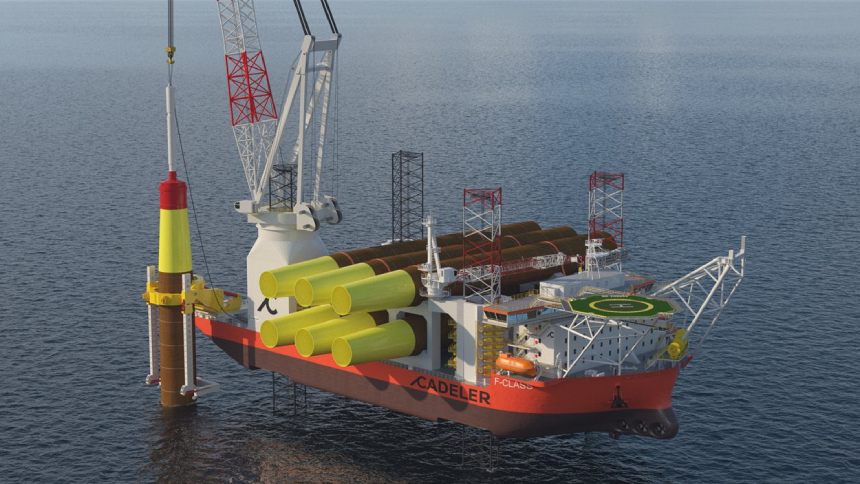
Now, Cadeler, the Danish WTIV company has reassured investors by announcing both a capital raising and a contract win for its first new “F-class” foundation installation vessel (FIV), the fifth vessel in its fleet, which is under construction at Cosco Heavy Industries in China for delivery at the end of 2025 (here).
In May, Cadeler completed a private placement of just over 26 million shares priced of NOK32.32 (US$3.03) apiece to raise around US$85 million. Last week, it followed up with a second sale of around 33 million new shares in a private placement, raising approximately US$95 million.
The net proceeds from the private placement will be used to part finance the company’s second F-class foundation installation newbuild (here), Cadeler said.
Contract win for 2027 to 2030 lays foundation
The first US$345 million new build, F-class foundation vessel has now won a contract from 2027 to 2030 with an unnamed client with a minimum guaranteed utilisation and a high level of flexibility for the nameless client to freely choose to either install foundations or wind turbines (here). If all options are called during the four-year agreement, Cadeler says that the value of the potential agreement will exceed €330 million (US$321.59 million).
Good luck to Cadeler in estimating what its operating costs and crew wages will be in 2030 in the current highly inflationary environment. However, sealing both the new cash infusion and the new F-class contract provide revenue visibility to the company and reassurance to both lenders and investors.
And by 2030, the cost problems of a bid made in 2022 may well be somebody else’s problem than that of the current management.
Eneti exposed
We warned (here) that Eneti’s decision to use its cash to buy back its own shares at a time when it has US$590 million still to pay to the Korean shipyard building its pair of high-specification WTIVs was short sighted and irresponsible, but likely benefited the management’s own incentive programme.
Cadeler and Seaway7’s capital raising and contract wins leave Eneti left further behind.
That giant sucking sound you can hear in the distance is not Allseas’ subsea mining nodule collector in the Pacific Ocean. Rather, it’s the sound of cash being sucked into the investment-hungry wind industry.
Quick BVI update
As an aside, we can update that the BVI’s former premier, Andrew Fahie, remains banged up under house arrest on drug smuggling charges in Miami, and now another former BVI senior government official has been arrested for thieving, and a third member of the administration has been sent to the United States by the Drug Enforcement Agency (here).
Tropical paradise and flag of convenience, indeed. Perhaps Sir Richard Branson can help his fellow countrymen!
Background Reading
More political corruption allegations in Nigeria (here): “Iyorchia Ayu, the PDP national chairman, has broken his silence on the N1 billion bribery allegation levelled against him by the Rivers State Governor, Nyesom Wike…..” One billion naira = US$2.3 million.
The Transparency International Exporting Corruption 2022 report is available for download here.
An excellent The Print Youtube video by Shekhar Gupta gives an Indian perspective on the ABG Shipyard fraud here.
The Center for Biological Diversity’s condemnation of the deepsea mining test is here.
Our initial coverage of Mr Fahie’s arrest in Florida, along with the BVI director of ports and her son, is here.


